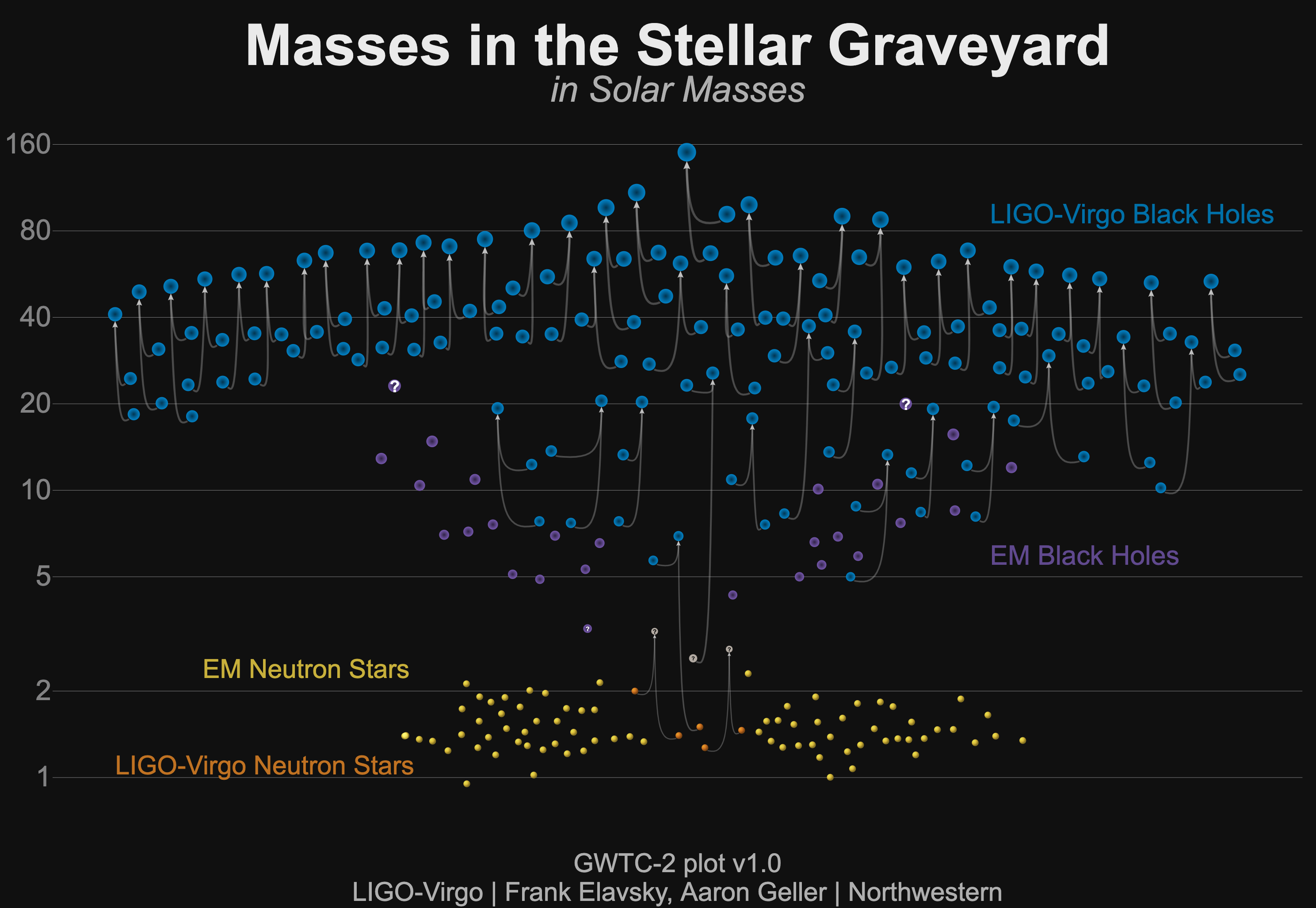Orrery of compact binaries
Summary
We present an updated catalog (GWTC-2 or the "Gravitational-Wave Transient Catalog 2") of gravitational-wave detections by LIGO and Virgo from the very first observation in 2015 to the end of O3a, the first half of the third observing period. O3a ran from April 1st to October 1st, 2019, and added 39 gravitational-wave events to the 11 confirmed events listed in GWTC-1, bringing the total to 50 events in GWTC-2. The discoveries of O3a span a wide range of astrophysical parameters and represent sources consistent with the coalescences of binary black holes (BBH), binary neutron stars (BNS) and neutron star black hole (NSBH) binaries.
Remarkably, O3a produced about three times more confidently-detected gravitational-wave events than the two previous observing periods (O1 and O2) combined. Furthermore, the Virgo detector was able to join the two LIGO detectors for the full duration of O3a, with at least one detector observing for about 97% of the time, and at least two observing for about 82% of the time. Some especially interesting O3a events include the second ever gravitational-wave observation consistent with a binary neutron star merger, the first events with unequivocally unequal masses, and a very massive black hole binary with a total mass of about 150 times the mass of the Sun. In this summary we describe the improvements within LIGO and Virgo which made this possible as well as the significance of these events to the field of astrophysics. We end with Indian contributions towards the GWTC-2 and media contacts.

Exceptional Discoveries of O3a
- GW190412: the first BBH with definitively asymmetric component masses, which also shows evidence for higher harmonics
- GW190425: the second gravitational-wave event consistent with a BNS, following GW170817
- GW190426_152155: a low-mass event consistent with either an NSBH or BBH
- GW190514_065416: a BBH with the smallest effective aligned spin of all O3a events
- GW190517_055101: a BBH with the largest effective aligned spin of all O3a events
- GW190521: a BBH with total mass over 150 times the mass of the Sun
- GW190814: a highly asymmetric system of ambiguous nature, corresponding to the merger of a 23 solar mass black hole with a 2.6 solar mass compact object, making the latter either the lightest black hole or heaviest neutron star observed in a compact binary
- GW190924_021846: likely the lowest-mass BBH, with both black holes exceeding 3 solar masses
Indian contributions to the GWTC-2 (O3a catalog & companion papers)
Researchers from ICTS were part of the Parameter Estimation Rota for determining properties of the compact objects which produced the gravitational waves detected by LIGO and Virgo detectors. An important measure of these detected candidates is the probability that they are of astrophysical origin. They also contributed to this measure of the significance of the candidate events. The inspiral-merger-ringdown consistency tests were carried out on events from O3a Catalog to check the consistency of final masses and spins inferred from the inspiral and post-inspiral parts of the gravitational wave signal. Offline analysis was carried out on all data sets to detect coalescing compact binaries and measure the astrophysical parameters of detected sources. The research groups at ICTS, IIT-Bombay and IUCAA were involved with this work. In addition the CMI working group contributed to the TGR paper by testing the binary black hole nature using the Spin-induced quadrupole moment analysis and in reviewing the Lorentz Violation and Modified Dispersion test for the O3a Catalog.
